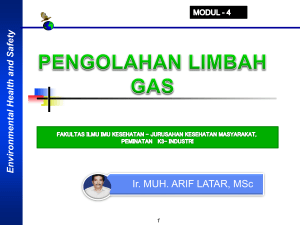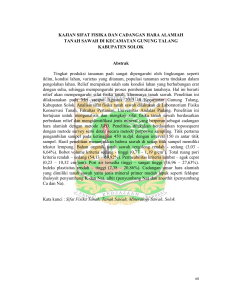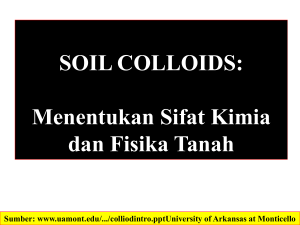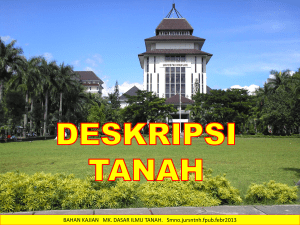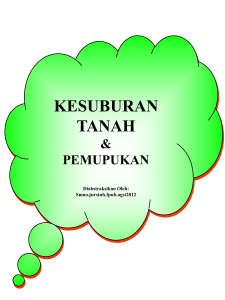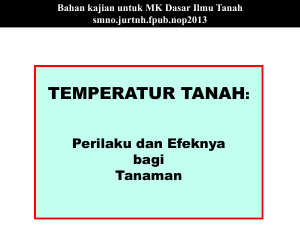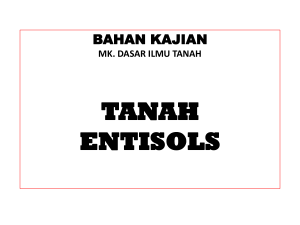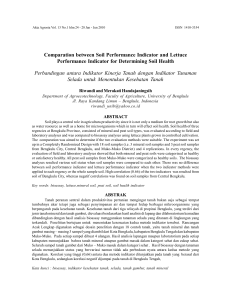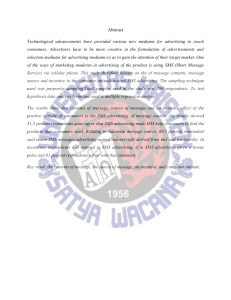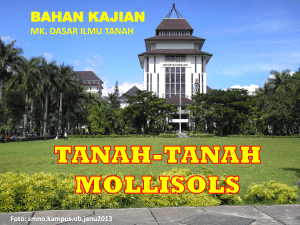Soil Taxonomy
advertisement
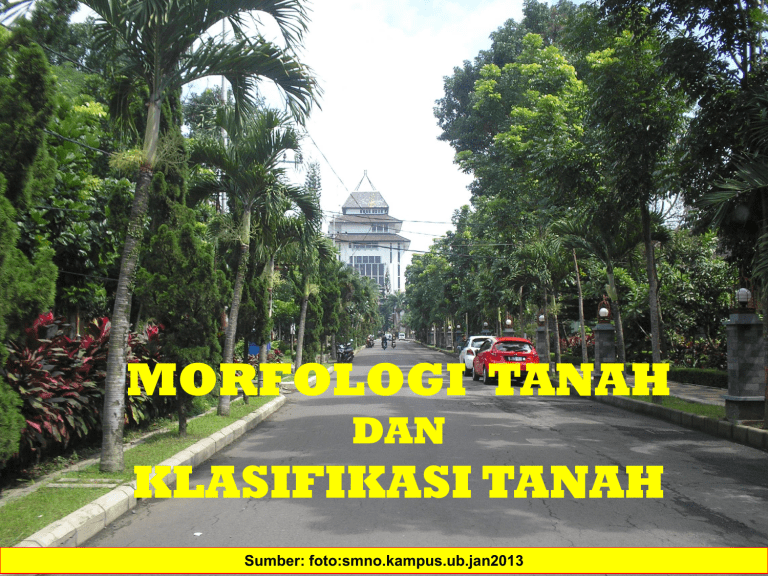
MORFOLOGI TANAH DAN KLASIFIKASI TANAH Sumber: foto:smno.kampus.ub.jan2013 MORFOLOGI TANAH SOIL MORPHOLOGY - SIFAT-SIFAT TANAH yang dapat DIAMATI di LAPANGAN dalam berbagai horison tanah , dan deskripsi macam dan tatanan horison. C.F. Marbut championed reliance on soil morphology instead of on theories of pedogenesis for soil classification because theories of soil genesis are both ephemeral and dynamic (Soil Survey Staff (1993). Soil Survey Manual. Washington D.C.: U. S. Government Printing Office. Soil Conservation Service, United States Department of Agriculture Handbook 18). Sifat-sifat yang dapat diamati dan dideskripsikan di lapangan meliputi: komposition, bentuk, struktur tganah dan organisasi tanah, warna tanah dan becak-becaknya, distribusi akar dan pori, bukti-bukti adanya translokasi material seperti carbonates, iron, manganese, carbon dan clay; serta konsistensi tanah. Observasi lapangan biasanya dilakukan pada suatu PROFIL TANAH. Profil tanah merupakan potongan vertikal dua dimensi, dalam tanah dan terikat pada salah satu sisi suatu PEDON. PEDON adalah unit tiga dimensi terkecil, tetapi tidak kurang dari 1 m2 di permukaan tanah yang mampu menangkap variabilitas lateral. Sumber: . http://en.wikipedia.org/wiki/Soil_morphology …….. DIUNDUH 25/2/2013 HORISON TANAH HORISON TANAH merupakan “lapisan” yang sejajar dnegan permukana tanah, karakteristik fisiknya berbeda dengan lapisanlapisan di atas dan di bawahnya. Setiap tanah mempunyai minimum satu horison, biasanya tiga atau empat horison. Horizons dicirikan oleh sifat-sifat fisikanya, terutama warna dan teksturnya. Sifat-sifat ini dapat dideskripsikan secara absolut (mis. Distribusi ukuran partikel, untuk tekstur tanah) dan secara relatif dalam kaitannya dnegan material skeitarnya , mis. Lebih kasar atau lebihberpasir dibandingkan dnegan horison di sebelah atas atau bawahnya. Sumber: . http://en.wikipedia.org/wiki/Soil_horizon …….. DIUNDUH 25/2/2013 MORFOLOGI TANAH O (Organic matter): Lapisan seresah sisa-sisa tumbuhan yang relatif masih belum mengalami dekomposisi. A (Tanah permukaan) : Lapisan tanah mineral dengan akumulasi bahan organik dan soil life. Lapisan ini meng-eluviasikan iron, liat, aluminum, senyawa organik, dan komponen terlarut lainnya. Kalau eluviasi ini snagat intensif, akan tampak horison E yang warnanya lebih terang di bagian bawah horison A. A-horizons may also be the result of a combination of soil bioturbation and surface processes that winnow fine particles from biologically mounded topsoil. In this case, the A-horizon is regarded as a "biomantle". B (Subsoil): Lapisan ini mengakumulasikan besi, liat, aluminum dan senyawa organik, prosesnya disebut ILUVIASI. C (Batuan/Bahan Induk) : Lapisan batuan berukuran besar-besra yang belum hancur. Lapisan ini mengakumulasikan senyawasenyawa yang dapat larut . R (Batuan dasar): Lapisan batuan-dasar yang baru lapuk parsial, di bagian dasar prosil tanah. Horison ini terdiri atas massa yang kontinyus, batuan keras yang tidak dapat digali dnegan tangan. Tanah-tanah yang terbentuk secara in situ akan menunjukkan kesamaan dengan batuan-dasar ini. Sumber: . http://en.wikipedia.org/wiki/Soil_horizon …….. DIUNDUH 25/2/2013 KLASIFIKASI TANAH KLASIFIKASI TANAH: berkenaan (berhubungan) dengan KATEGORISASI TANAH SECARA SISTEMATIS berdasarkan pada karakteristik pembeda (penciri) dan kriteria yang telah ditetapkan. Sistem Internasional saat ini: 1. Buol, S.W., Southard, R.J., Graham, R.C., and McDaniel, P.A. (2003). Soil Genesis and Classification, 5th Edition. Iowa State Press - Blackwell, Ames, IA. 2. Driessen, P., Deckers, J., Spaargaren, O., & Nachtergaele, F. (Eds.). (2001). Lecture notes on the major soils of the world. Rome: FAO. 3. FAO. (1998). World Reference Base for Soil Resources. Rome: Food and Agriculture Organization of the United Nations. Sumber: . http://en.wikipedia.org/wiki/Soil_classification …….. DIUNDUH 25/2/2013 KLASIFIKASI TANAH Untuk dapat mengelola lahan dengan tepat kita harus mengetahui seperti apa “tanah” yang kita hadapi, dan bagaimana tanah-tanah ini berbeda-beda di antara satu lokasi dengan lokasi lainnya. Sistem klasifikasi memungkinkan kita untuk mengkomunikasikan berbagai tanah-tanah ini dan pengelolaannya. Sumber: Keys to Soil Taxonomy, Eighth Edition. 1998. …….. DIUNDUH 15/2/2013 TAKSONOMI TANAH USDA Soil Taxonomy developed by United States Department of Agriculture and the National Cooperative Soil Survey provides an elaborate classification of soil types according to several parameters (most commonly their properties) and in several levels: Order, Suborder, Great Group, Subgroup, Family, and Series. Contoh klasifikasi suatu Tipe Tanah: Order Suborder Great Group Subgroup Family Series : Entisols : Fluvents : Torrifluvents : Typic Torrifluvents : Fine-loamy, mixed, superactive, calcareous, Typic Torrifluvents : Jocity, Youngston. Sumber: . http://en.wikipedia.org/wiki/USDA_soil_taxonomy …….. DIUNDUH 25/2/2013 ORDO TANAH 1. Alfisols — pelapukan moderat, berkembang pada kondisi hutan berdaun lebar atau boreal, kaya Fe dan Al. 2. Andisols — berkembang pada bahan abu-vulkanik, dan kaya bahan-bahan koloidal gelas dan amorf, termasuk allophane, imogolite dan ferrihydrite. 3. Aridisols — (dari bahasa Latin “aridus” berarti “kering”) tanah berkembang pada kondisi iklim arid atau semiarid 4. Entisols — tidak menunjukkan perkembangan profil tanah yang "significant“. Horison-horisn tanah minimal. … dst ….. Sumber: . http://en.wikipedia.org/wiki/USDA_soil_taxonomy …….. DIUNDUH 25/2/2013 HORISON UTAMA = Master Horizons Informasi tentang tanah O horizon A horizon R horizon E horizon (Elluvial) C horizon B horizon (Illuvial) B horizon Sumber: soillab.ifas.ufl.edu/.../Lecture%2023%20Soil%20Taxonomy.ppt …….. DIUNDUH 15/2/2013 Pengenalan Sub-horizon Pembeda Subordinate di dalam Horison Utama p – pembajakan/pengolahan/gangguan t – akumulasi liat g – pembentukan glei h – illuvial bahan organik w – perkembangan warna/ struktur o – oksik Sumber: soillab.ifas.ufl.edu/.../Lecture%2023%20Soil%20Taxonomy.ppt …….. DIUNDUH 15/2/2013 Pembeda (penciri) Subordinat (p = plowed) Horison permukaan yang terganggu (kultivasi, pasture, kehutanan) Digunakan dnegan Horison A (mis. Horison Ap) Ap horizon Contoh deskripsi Ap: Ap -- 0 - 12 inch; coklat tua (10YR 3/3) Lemoung liat berdebu; struktur gumpal-bersudut , halus, kuat; remah, agak lekat dan plastis; banyak akar; banyak pori halus dan medium; sangat masam (pH 4.8); batas horison abrupt smooth. (tebalnya 10 - 13 inch). Sumber: http://nesoil.com/images/paxton.htm …… DIUNDUH 15/2/2013 Subordinate distinction (t = clay accumulation) Translokasi liat atau terbentuk di tempat Coatings atau diskrit Digunakan dnegan Horison B (mis. Horison Bt) Kalau reduksi, dapat digunakan dengan subhorizon g (mis. Horison Btg) Contoh deskripsi Horison Bt: B21 -- 12 - 22 inch; coklat tua (7.5YR 3/2) lempung liat berdebu; struktur prismatik medium moderat yang bercampur dengan struktur gumpal bersudut halus mdeium moderat; keras, gembur, agak lekat, plastis dan licinmoderat; banyak akar; banyak pori halus dan sangat halus; banyak selimut berbutir halus pada pori dan pada ped; sangat masam (pH 5.5); batas horison clear smooth. (tebal 10 - 12 inch) Sumber: soillab.ifas.ufl.edu/.../Lecture%2023%20Soil%20Taxonomy.ppt …….. DIUNDUH 15/2/2013 Pembeda Subordinat (g = gleying) 1. 2. 3. 4. Oksigen kurang atau kondisi reduksi karena jenuh air. Reduksi besi (Fe III menjadi Fe II) Khroma rendah Sering digunakan dnegan Horison B (mis. Horison Bg), juga dnegan horison E dan C. Fe3+ Material oksidasi oksidasi Fe2+ Material glei Photographs showing redoximorphic features (soil mottling) which are color patterns in the soil formed by the oxidation and reduction of iron and/or manganese caused by saturated conditions within the soil. Redoximorphic features are used to estimate the depth to seasonal high watertable Sumber: soillab.ifas.ufl.edu/.../Lecture%2023%20Soil%20Taxonomy.ppt …….. DIUNDUH 15/2/2013 Subordinate distinction (h = akumulasi organik) 1. 2. 3. 4. 5. Akumulasi iluvial kompleks bahan organik - logam Selimut pada pasir dan partikel diskrit h = “humik” Value dan chroma sekitar 3 atau kurang Digunakan dnegan Horison B (mis. Horison Bh) Contoh: Horison Bh : Horison subsoil , 'B' menyatakan horison B dan 'h' menyatakan “humik”. Bahan organik dan aluminium snagat dominan (sedikit sekali sneyawa besi). Istilah ini digunakan untuk mendefinisikan Ordo Podosol dalam sistem klasifikasi “Australian Soil Classification” (Isbell, 1996). Horison Bh pada kedalaman 30-40 cm di lokasi West Gippsland Podosol. Horison Bh “horison spodik” Sumber: soillab.ifas.ufl.edu/.../Lecture%2023%20Soil%20Taxonom y.ppt …….. DIUNDUH 15/2/2013 Sumber: http://vro.dpi.vic.gov.au/dpi/vro/vrosite.nsf/pages/gloss _AC…….. DIUNDUH 25/2/2013 Pembeda Subordinat (w = warna atau struktur) Perkembangan warna atau struktur secara Nonilluvial “w” dapat = “weak” Biasanya digunakan dnegan Horison B (mis. Bw.) Bw Sumber: soillab.ifas.ufl.edu/.../Lecture%2023%20Soil%20Taxonomy.ppt …….. DIUNDUH 15/2/2013 Pembeda Subordinat (o = horison oksik) Aktivitas liat rendah Sedikti material dapat lapuk Struktur batuan tampak sedikit Oksida Fe dan Al Horison oksik mempunyai: a. The CEC7 < 16cmol(+)/kg of clay and an ECEC < 12 cmol(+)/kg of clay which is due to the low activity clay minerals (1:1 clays, Fe and Al oxides, etc) b. < 10% mineral dapat lapuk dalam fraksi pasir c. Struktur batuan < 5% Sumber: soillab.ifas.ufl.edu/.../Lecture%2023%20Soil%20Taxonomy.ppt …….. DIUNDUH 15/2/2013 Pembeda Subordinat g – gleying h – illuvial bahan organik p – pengolahan tanah / pembajakan/ gangguan t – akumulasi liat w – perkembangan warna / struktur tanah o – oksik Sumber: soillab.ifas.ufl.edu/.../Lecture%2023%20Soil%20Taxonomy.ppt …….. DIUNDUH 15/2/2013 PEMBEDA SUBORDINAT & BAHAN ORGANIK Sumber: soillab.ifas.ufl.edu/.../Lecture%2023%20Soil%20Taxonomy.ppt …….. DIUNDUH 15/2/2013 Subordinate distinction (a, e, i) Menyatakan derajat dekomposisi bahan organik dalam Horison O. Oa – dekomposisi lanjut (saprik) Oe – dekomposisi moderat (hemik) Oi – dekomposisi ringan (fibrik) Saprik –decomposisi lanjut, serat tumbuhan sedikit, kadar air rendah Hemik –dekomposisi intermedier Fibrik – dekomposisi ringan, serat-serat masih dapat dikenali Sumber: soillab.ifas.ufl.edu/.../Lecture%2023%20Soil%20Taxonomy.ppt …….. DIUNDUH 15/2/2013 IKHTISAR Horison Utama: O, A, E, B, C, R Simbul Sub horizon : g, h, p, t, w and a,e,i Contoh: Oa, Oe, Oi Bt Bg Btg Bw Ap Sumber: soillab.ifas.ufl.edu/.../Lecture%2023%20Soil%20Taxonomy.ppt …….. DIUNDUH 15/2/2013 OTHER DESIGNATIONS Sumber: soillab.ifas.ufl.edu/.../Lecture%2023%20Soil%20Taxonomy.ppt …….. DIUNDUH 15/2/2013 Pembagian Vertikal Dicirikan oleh horison utama yang serupa dan/atau ciri-ciri subordinat yang dipisahkan oleh “derajat”. Horison Bt Bt1 Bt2 Bt3 Sumber: soillab.ifas.ufl.edu/.../Lecture%2023%20Soil%20Taxonomy.ppt …….. DIUNDUH 15/2/2013 Horison Transisi Lapisan transisi di antara horison utama. AE EB BE Karakter Dominan Karakter Subordinat Sumber: soillab.ifas.ufl.edu/.../Lecture%2023%20Soil%20Taxonomy.ppt …….. DIUNDUH 15/2/2013 Synthesis Ap AE E Bh Btg1 Btg2 Stages of development of soils across time for a soil in the central United States under forest. (diunduh dari: http://www.soils.wisc.edu/courses/SS325/formation.htm … 25/2/2013 Sumber: soillab.ifas.ufl.edu/.../Lecture%2023%20Soil%20Taxonomy.ppt …….. DIUNDUH 15/2/2013 SOIL TAXONOMY Sumber: soillab.ifas.ufl.edu/.../Lecture%2023%20Soil%20Taxonomy.ppt …….. DIUNDUH 15/2/2013 TAKSONOMI TANAH Ada banyak sistem klasifikasi tanah yang digunakan saat ini, masing-masing memenuhi kebutuhan negara penggunanya. Salah satunya adalah “Soil Taxonomy”, sisten klasifikasi tanah yg dipakai di USA dan di berbagai negara dunia lainnya. “Soil Taxonomy” menggunakan konsep tanah sebagai “tubuh alamiah” dan mendasarkan pada ciri-ciri tanah yang dapat diamati dan diukur. Sistem ini juga menggunakan tata-nama unik yang mencerminkan karakteristik utama dari tanah. Soil Taxonomy utilizes many chemical, physical, and biological properties including soil moisture and soil temperature status. In addition, the presence or absence of certain diagnostic horizons in the soil profile helps ascertain the soil's classification category. A diagnostic horizon is a layer or soil zone whose properties meet certain criteria specified for the purposes of classification. Horison penciri (diagnostik) dapat terdiri atas satu atau lebih horison genetik. Tujuh horison penciri ini disebut “EPIPEDON”, horion permukaan. Delapan-belas horison penciri bawah-permukaan digunakan untuk mencirikan berbagai tanah dalam sistem Soil Taxonomy. Selain itu, lima rezim lengas tanah dan sepuluh rezim suhu tanah membantu untuk mengidentifikasi “kategori” tanah. Sumber: soillab.ifas.ufl.edu/.../Lecture%2023%20Soil%20Taxonomy.ppt …….. DIUNDUH 15/2/2013 KATEGORI TAKSONOMI TANAH Dalam sistem Soil-Taxonomy, semua tanah di dunia diklasifikasikan dalam kategori berikut (dari pengelompokkan secara umum hingga “tanah” yg paling spesifik): ordo (12), subordo (63), great groups (sekitar 250), subgroups (sekitar 1,400), famili (sekitar 8,000), dan seri ( > 20,000). Semua tanah termasuk ke dalam salah satu dari 12 ordo, yang dari ordo lainnya terutama oleh adanya atau tidak adanya “HORISON PENCIRI” Dalam setiap ORDO ada SUB-ORDO yang dibedakan satu sama lainnya oleh perbedaan rezim lengas-tanah dan rezim suhu-tanah, dan oleh ciri-ciri fisika dan kimia yang dominan.. In turn, each suborder is subdivided into great groups differing in the presence or absence of diagnostic horizons (including impervious pans), and in levels of certain chemicals such as clays and salts. Each great group is comprised of a number of subgroups that are characterized by a central (typic) member and by other members that are intergrades toward other orders, suborders or great groups, or that have characteristics not shared with the typic member. Within each subgroup are soil families that vary in properties that are important for plant growth or for engineering uses of the soil. Dalam setiap FAMILI ada sejumlah SERI-TANAH, kategori yang paling spesifik dari sistem klasifikasi ini. SERI-TANAH diidentifikasi dalam survei lokal dan diberi nama yang “bermakna lokal” (mislanya nama lokasinya). Sumber: soillab.ifas.ufl.edu/.../Lecture%2023%20Soil%20Taxonomy.ppt …….. DIUNDUH 15/2/2013 KLASIFIKASI TANAH / TAKSONOMI Hierarkhis Profil Tanah Berdasarkan karakteristik profil tanah dan Konsep tanah sebagai tubuh alami. Ciri-ciri yang tampak: warna, tekstur, struktur, pH, BO,….… GENESIS TANAH 1883 V.V. Dukachaev: climate, vegetation, soil 1927 C.F. Marbut (USDA) applied to U.S. (1965) Sumber: soillab.ifas.ufl.edu/.../Lecture%2023%20Soil%20Taxonomy.ppt …….. DIUNDUH 15/2/2013 TERMINOLOGI TAKSONOMI TANAH Nama kelas tanah mencerminkan ciri-ciri tanah. Tata-nama bersifat logis dan sederhana. Misalnya, “akar” dari nama-nama ordo tanah diambil dari kata-kata Latin, Greek, atau salah satu dari bahasa modern. Kepada “akar” ini ditambahkan suatu sukukata “sols”. Sehingga “akar” dari Mollisols berasal dari bahasa Latin “mollis”, yang berarti “lunak”, ini mencerminkan ciri tanah yang gembur dan mudah diolah. The names of specific class members in categories below that of soil orders include the root elements of the soil order name plus specific formative elements or expressions that suggest distinctive soil properties. For example, consider the names of the lower categories of Alfisols and Mollisols that are formed under somewhat dry conditions (Ustic-Latin ustus, burnt implying dryness), have a natric (high sodium (Na)) horizon and are typical of the subgroup in which they are classed: Ordo Alfisols Mollisols Subordo (kering) Ustalfs Ustolls Great group (natrik) Natrustalfs Natrustolls Subgroup (typical) Typic Natrustalfs Typic Natrustolls Nama famili-tanah menyatakan tekstur tanah, komposisi mineral, dan kelas suhutanah hingga lapisan tanah-atas 50 cm, seperti Typic Natrustolls, smectitik halus, mesik. Nama Seri-tanah berhubungan dnegan lokasi tempat pertama-kalinya “tanah” diklasifikasikan (diidentifikasi/dideskripsikan). Sumber: soillab.ifas.ufl.edu/.../Lecture%2023%20Soil%20Taxonomy.ppt …….. DIUNDUH 15/2/2013 HIERARKHI KLASIFIKASI TANAH / TAKSONOMI Ordo 12 Subordo 63 Great group 250 Sub group 1400 Famili 8000 Seri Kingdom Phylum Class Order Family Genus Species 19,000 Sumber: soillab.ifas.ufl.edu/.../Lecture%2023%20Soil%20Taxonomy.ppt …….. DIUNDUH 15/2/2013 UNIT-UNIT UNTUK KLASIFIKASI TANAH Pedon – unit tiga dimensi terkecil yg menyajikan seluruh sifat dari ciri suatu tanah (luasnya 1-10 m2) - Unit dasar dari klasifikasi tanah. Polipedon – kelompok pedon yang berhubungan erat di lapangan Seri Tanah – class of soils world-wide which share a common suite of soil profile properties Sumber: soillab.ifas.ufl.edu/.../Lecture%2023%20Soil%20Taxonomy.ppt …….. DIUNDUH 15/2/2013 The two extremes of most soil classification systems are the soil that represents all soils collectively around the world, and a soil that is a specific natural body with characteristics that distinguish it from other such natural bodies. Suatu tanah dapat dikarakterisasikan oleh suatu unit (hipottetis) kecil tiga-dimensi yang disebut “PEDON”, luasnya sekitar 10 m2 di permukaan. Area ini terlalu kecil untuk berfungsi sebagai unit klasifikasi lapangan yang praktis. Akan tetapi beberapa PEDON yang saling bersambungan kontinyu satu-sama lain yang merupakan POLIPEDON pada akhirnya menjadi apa yang disebut “INDIVIDU TANAH”. INDIVIDU-TANAH ini setara dengan SERI-TANAH. Lanskap Polipedon Individu Tanah Pedon Profil tanah Unit sampling tanah Lanskap Polipedon Pedon Seri Malabar Sumber: soillab.ifas.ufl.edu/.../Lecture%2023%20Soil%20Taxonomy.ppt …….. DIUNDUH 15/2/2013 HORISON PENCIRI Horison Permukaan Horison tanah, sifat-ciri dan material dimaksudkan untuk merefleksikan sifatsifat tanah dan yang dapat dipakai untuk mendeskripsikan dan mendefinisikan kelas-tanah. Mereka dianggap sebagai “penciri” atau "diagnostic" kalau memenuhi derajat ekspresi minimum, yang ditentukan oleh kenampakannya, pengukurannya, kepentingannya, relevansinya dan kriteria kuantitatifnya. Horison Bawahpermukaan To be considered diagnostic, soil horizons also require a minimum thickness, which must be appraised in relation to bioclimatic factors (e.g. an albic horizon in boreal regions is not expected to be as thick as one in the tropics). Sumber: soillab.ifas.ufl.edu/.../Lecture%2023%20Soil%20Taxonomy.ppt …….. DIUNDUH 15/2/2013 HORISON-PERMUKAAN PENCIRI Epipedons Apakah horison mineral ? Molik Umbrik Okhrik Histik Melanik Plaggen Anthropik Jenuh air > 30 hari Apakah horison kaya P2O5 ? Apakah kejenuhan basa >50%? Sumber: http://www.soils.wisc.edu/courses/SS325/organic.htm…….. DIUNDUH 25/2/2013 HORISON PERMUKAAN PENCIRI X = Florida Melanik X Plaggen Histik Molik X Umbrik X Anthropik Okhrik X Sumber: soillab.ifas.ufl.edu/.../Lecture%2023%20Soil%20Taxonomy.ppt …….. DIUNDUH 15/2/2013 EPIPEDON MOLIK Tebal > 18-25 cm Warna - Color C-Organik Kejenuhan basa Value < 3.5 lembab Khroma < 3.5 lembab > 0.6 % > 50 % Struktur Sangat berkembang C-Organik = Bahan organik x 0.5 Sumber: soillab.ifas.ufl.edu/.../Lecture%2023%20Soil%20Taxonomy.ppt …….. DIUNDUH 15/2/2013 EPIPEDON UMBRIK Memenuhi semua kriteria epipedon Molik, kecuali kejenuhan basanya < 50% Secara kimiawi berbeda dnegan Molik Sumber: soillab.ifas.ufl.edu/.../Lecture%2023%20Soil%20Taxonomy.ppt …….. DIUNDUH 15/2/2013 EPIPEDON OKHRIK Terlalu: tipis terang warna miskin BO Mollic Umbric Okhrik = pucat Extremely common Sumber: soillab.ifas.ufl.edu/.../Lecture%2023%20Soil%20Taxonomy.ppt …….. DIUNDUH 15/2/2013 EPIPEDON HISTIK Horison Organik Terbentuk di daerah basah Hitam – Coklat tua Bobot isinya rendah Tebalnya 20-30 cm Organik = > 20% - 35% BO. (kejenuhan air, kadar liat) Sumber: soillab.ifas.ufl.edu/.../Lecture%2023%20Soil%20Taxonomy.ppt …….. DIUNDUH 15/2/2013 EPIPEDON MELANIK Similar in properties to Mollic Formed in volcanic ash Lightweight, Fluffy Sumber: soillab.ifas.ufl.edu/.../Lecture%2023%20Soil%20Taxonomy.ppt …….. DIUNDUH 15/2/2013 HORISON ANTHROPIK 1. 2. 3. 4. Resembles mollic (color, o.m.) Use by humans Shells and bones Water from humans Sumber: soillab.ifas.ufl.edu/.../Lecture%2023%20Soil%20Taxonomy.ppt …….. DIUNDUH 15/2/2013 Plaggen Epipedon Produced by long-term (100s yrs.) manuring Horison permukaan yang tua dan hasil aktivitas manusia Tebalnya > 50 cm Sumber: soillab.ifas.ufl.edu/.../Lecture%2023%20Soil%20Taxonomy.ppt …….. DIUNDUH 15/2/2013 HORISON PERMUKAAN PENCIRI Epipedon: Molik Umbrik Ochrik Histik Melanik Plaggen Anthropik Sangat umum “spesifik” Hasil aktivitas manusia Sumber: soillab.ifas.ufl.edu/.../Lecture%2023%20Soil%20Taxonomy.ppt …….. DIUNDUH 15/2/2013 AKUMULASI BAHAN ORGANIK Akumulasi BO Histik Mollik, Umbrik ochrik waktu Bahan induk Vegetasi tmax = 3000 tahun Sumber: soillab.ifas.ufl.edu/.../Lecture%2023%20Soil%20Taxonomy.ppt …….. DIUNDUH 15/2/2013 DIAGNOSTIC SUB-SURFACE HORIZONS HORISON BAWAH-PERMUKAAN PENCIRI Sumber: soillab.ifas.ufl.edu/.../Lecture%2023%20Soil%20Taxonomy.ppt …….. DIUNDUH 15/2/2013 HORISON BAWAH-PERMUKAAN PENCIRI Pembentukan/Genesis Translokasi Transformasi Liat Bahan Organik Oksida Sumber: soillab.ifas.ufl.edu/.../Lecture%2023%20Soil%20Taxonomy.ppt …….. DIUNDUH 15/2/2013 HORISON BAWAH-PERMUKAAN Genesis Translokasi Transformasi Bahan Organik Warna gelap Logam (Fe, Al) Liat Smectites Kaolinite Oksida Iron Aluminum Juga: Garam, Karbonat, Sulfida Sumber: soillab.ifas.ufl.edu/.../Lecture%2023%20Soil%20Taxonomy.ppt …….. DIUNDUH 15/2/2013 HORISON BAWAH-PERMUKAAN PENCIRI Albik Argillik Spodik Oksik Cambik Kandik Sombrik Sulfurik Natrik Agrik Kalsik Gipsik Salik Duripan Fragipan Plasik Penyebutan Sub-Horizon Sumber: soillab.ifas.ufl.edu/.../Lecture%2023%20Soil%20Taxonomy.ppt …….. DIUNDUH 15/2/2013 HORISON BAWAH-PERMUKAAN PENCIRI Horison Albik (putih) Warna terang (Value > 6 lembab ) Elluvial (Horison E *) Miskin liat, oksida Fe dan Al Umumnya berpasir Reaktivitas kimiawi rendah (KTK rendah) Typically overlies Bh or Bt horizons Warna terang albic *Tidak semua horison E adalah horison albik Sumber: soillab.ifas.ufl.edu/.../Lecture%2023%20Soil%20Taxonomy.ppt …….. DIUNDUH 15/2/2013 HORISON BAWAH-PERMUKAAN PENCIRI Horison Argilik Illuvial accumulation of silicate clays Illuvial based on overlying horizon Jembatan Liat Selimut Liat Sumber: soillab.ifas.ufl.edu/.../Lecture%2023%20Soil%20Taxonomy.ppt …….. DIUNDUH 15/2/2013 HORISON BAWAH-PERMUKAAN PENCIRI Horizon Argilik Tinggi Aktivitas liat Necessary Illuviasi liat Horison Kandik Rendah Not Necessary Sumber: soillab.ifas.ufl.edu/.../Lecture%2023%20Soil%20Taxonomy.ppt …….. DIUNDUH 15/2/2013 HORISON BAWAH-PERMUKAAN PENCIRI Horison Spodik • Illuvial accumulation of organic matter and aluminum (+/- iron) • Dark colored (value, chroma < 3) • Low base saturation (acidic) • Formed under humid acid conditions Spodic Sumber: soillab.ifas.ufl.edu/.../Lecture%2023%20Soil%20Taxonomy.ppt …….. DIUNDUH 15/2/2013 Elluviation and Illuviation Elluviation (E horizon) Organic matter Clays A A E E Bh horizon Bt horizon Bt Bh Spodic horizon Argillic horizon Sumber: soillab.ifas.ufl.edu/.../Lecture%2023%20Soil%20Taxonomy.ppt …….. DIUNDUH 15/2/2013 HORISON BAWAH-PERMUKAAN PENCIRI Oxic horizon • Highly weathered (high temperatures, high rainfall) - High in Fe, Al oxides activity - High in low-activity clays (kaolinite < smectite < vermiculite) Sumber: soillab.ifas.ufl.edu/.../Lecture%2023%20Soil%20Taxonomy.ppt …….. DIUNDUH 15/2/2013 HORISON PENCIRI = Diagnostic Horizons Epipedons Mollic Umbric Ochric Histic Melanic Plaggen Anthropic PERMUKAAN Subsurface Albic Kandic Argillic Spodic Oxic BAWAH-PERMUKAAN Sumber: soillab.ifas.ufl.edu/.../Lecture%2023%20Soil%20Taxonomy.ppt …….. DIUNDUH 15/2/2013 SOIL TAXONOMY 1. Diagnostic Epipedons 2. Diagnostic Subsurface horizons 3. Moisture Regimes 4. Temperature Regimes Sumber: soillab.ifas.ufl.edu/.../Lecture%2023%20Soil%20Taxonomy.ppt …….. DIUNDUH 15/2/2013 DIAGRAM DERAJAT PERKEMBANGAN TANAH Histosols (organik) Gelisols Aridisols (permafrost) (kering) Alfisols (liat agak masam) Ultisols (liat sngt masam) Entisol Oxisols (recent) (Oksida) Spodosols Mollisols (Horison Spodik) (Lunak, gelap) Vertisols Inceptisols (Baru mulai) (Liat mengembang) Andisols (Vulkanik) Derajat pelapukan dan perkembangan tanah Ringan /sedikit Intermediate Kuat Sumber: Keys to Soil Taxonomy, Eighth Edition. 1998. …….. DIUNDUH 15/2/2013 KUNCI ORDO TANAH Penciri utama Ordo Tanah Gelisols Tanah-tanah dengan permafrost di dalam 100 cm atau cryoturbasi dan permafrost di dalam 200 cm Histosols Tanah-tanah dengan horison spodik di dalam 2 m permuakan tanah dan tanpa ciri andik Spodosols Tanah-tanah dengan ciri andik (BI rendah, bahan gelas vulkanik, pumice, …) Andisols Tanah-tanah dengan horison oksik di dalam 150 cm permukaan tanah Oxisols Tanah-tanah dengan 30% atau lebih liat hingga kedalaman 50 cm dan ciri mengembang-mengkerut Vertisols Tanah-tanah dengan rezim kelengasan aridik dan menunjukkan perkembangan horison B atau horison salik Aridisols Tanah-tanah dg horison argilik atau kandik atau fragipan dan kejenuhan basanya <35% pd kedalaman 2 m atau 75 cm di bawah fragipan Ultisols Tanah-tanah dg epipedon molik dan kejenuhan basa >50% hingga lapisan kedap atau pd 1.8 m dari permukaan tanah Mollisols Tanah-tanah dg horison argilik, kandik atau natrik atau fragipan dengan selimut liat Alfisols Tanah-tanah dg horison kambiki, sulfurik, kalsik, gipsik,petrokalsik, atau petrogipsik, atau dengan epipedon molik, umbrik, atau histik, atau dengan ESP > 15% , atau fragipan Inceptisols Entisols Sumber: Keys to Soil Taxonomy, Eighth Edition. 1998. …….. DIUNDUH 15/2/2013 UNSUR PEMBENTUK ORDO Ordo Tanah Derivasi Alfisols Unsur Pembentukan alf. Andisols Ando = tanah hitam Aridisols aridus = kering Entisols and. id. ent. Gelisols gelid = sangat dingin el. Histosols histos = jaringan ist. Inceptisols Inceptum = mulai, awal ept. Mollisols Mollis = lunak oll. Oxisols Oxide = oksida ox. Spodosols Spodos = abu kayu od. Ultisols Ultimus = akhir ult. Vertisols Verto = membalik ert. Sumber: Keys to Soil Taxonomy, Eighth Edition. 1998. …….. DIUNDUH 15/2/2013 UNSUR FORMATIF Unsur Formatif Konotasi unsur formatif alb Adanya horison albik (horison eluvial yang tercuci) anthr Adanya epipedon anthropik atau epipedon plaggen aqu Karakteristik yang berhubungan dnegan kebasahan ar Horison tercampur / campuran arg Adanya horisom argilik (horison dnegan liat iluvial) calc Adanya horison kalsik camb Adanya horison kambik Cry Dingin Clur Adanya duripan fibr Fase dekomposisi ringan / awal fluv Dataran banjir fol Massa dedaunan gyps Adanya horiosn gipsik hem Fase dekompoisisi intermedier UNSUR FORMATIF Unsur Formatif Konotasi unsur formatif Hist Adanya epipedon Histik Hum Adanya bahan organik orth Paling lazim per Iklim humid sepanjang tahun, rezim air perudik psamm Tekstur pasir rend Rendzinalike – kaya karbonat sal Adanya horison salik (saline) sapr Fase dekomposisi lanjut torr Biasanya kering turb Cryoturbasi ud Iklim humid ust Iklim kering, biasanya panas selama summer vitr Menyerupai gelas xer Sumer kering, winter lembab KUNCI TAKSONOMI TANAH: ORDO GELISOLS Tanah-tanah yang mempunyai: 1. Permafrost di dalam 100 cm tanah permukaan; atau 2. Material Gelik di dalam 100 cm tanah permukaan dan permafrost di dalam 200 cm tanah permukaan. Sumber: Keys to Soil Taxonomy, Eighth Edition. 1998. …….. DIUNDUH 15/2/2013 KUNCI TAKSONOMI TANAH: ORDO HISTOSOLS 1. Do not have andic soil properties in 60 percent or more of the thickness between the soil surface and either a depth of 60 cm or a densic, lithic, or paralithic contact or duripan if shallower; and 2. Mempunyai material tanah organik yg memenuhi satu atau lebih berikut: • Overlie cindery, fragmental, or pumiceous materials and/or fill their interstices1 and directly below these materials, have a densic, lithic, or paralithic contact; or • When added with the underlying cindery, fragmental, or pumiceous materials, total 40 cm or more between the soil surface and a depth of 50 cm; or • Constitute two-thirds or more of the total thickness of the soil to a densic, lithic, or paralithic contact and have no mineral horizons or have mineral horizons with a total thickness of 10 cm or less; or • Jenuh air selama 30 hari atau lebih per tahun pada tahun-tahun normal (atau drainage buatan), mempunyai batas atas di dalam 40 cm tanah permukaan, dan mempunyai tebal total : • 60 cm atau lebih kalau tiga-perempat atau lebih volumenya terdiri atas serat-moss atau kalau bobot-isinya pada kondisi lembab kurang dari 0.1 g/cm3; ATAU • 40 cm atau lebih kalau terdiri atas material saprik atau hemik, atau material fibrik dengan kurang dari tiga-perempat (volumenya) serat-moss dan bobot isinya pd kondisi lembab 0.1 g/cm3 atau lebih. Sumber: Keys to Soil Taxonomy, Eighth Edition. 1998. …….. DIUNDUH 15/2/2013 KUNCI TAKSONOMI TANAH: ORDO PODOSOLS Other soils that do not have a plaggen epipedon or an argillic or kandic horizon above a spodic horizon, and have one or more of the following: A spodic horizon, an albic horizon in 50 percent or more of each pedon, and a cryic soil temperature regime; or An Ap horizon containing 85 percent or more spodic materials; or A spodic horizon with all of the following characteristics: One or more of the following: A thickness of 10 cm or more; or An overlying Ap horizon; or Cementation in 50 percent or more of each pedon; or A coarse-loamy, loamy-skeletal, or finer particle-size class and a frigid temperature regime in the soil; or A cryic temperature regime in the soil; and An upper boundary within the following depths from the mineral soil surface: either Less than 50 cm; or Less than 200 cm if the soil has a sandy particle-size class in at least some part between the mineral soil surface and the spodic horizon; and A lower boundary as follows: Either at a depth of 25 cm or more below the mineral soil surface or at the top of a duripan or fragipan or at a densic, lithic, paralithic, or petroferric contact, whichever is shallowest; or At any depth, If the spodic horizon has a coarse-loamy, loamy-skeletal, or finer particle-size class and the soil has a frigid temperature regime; or If the soil has a cryic temperature regime; and Either: A directly overlying albic horizon in 50 percent or more of each pedon; or No andic soil properties in 60 percent or more of the thickness either: Within 60 cm either of the mineral soil surface or of the top of an organic layer with andic soil properties, whichever is shallower, if there is no densic, lithic, or paralithic contact, duripan, or petrocalcic horizon within that depth; or Between either the mineral soil surface or the top of an organic layer with andic soil properties, whichever is shallower, and a densic, lithic, or paralithic contact, a duripan, or a petrocalcic horizon. Sumber: Keys to Soil Taxonomy, Eighth Edition. 1998. …….. DIUNDUH 15/2/2013 KUNCI TAKSONOMI TANAH: ORDO ANDISOLS Tanah-tanah lain yang mempunyai ciri andik dalam 60 % atau lebih ketebalannya, yaitu: 1. Within 60 cm either of the mineral soil surface or of the top of an organic layer with andic soil properties, whichever is shallower, if there is no densic, lithic, or paralithic contact, duripan, or petrocalcic horizon within that depth; or 2. Between either the mineral soil surface or the top of an organic layer with andic soil properties, whichever is shallower, and a densic, lithic, or paralithic contact, a duripan, or a petrocalcic horizon. Sumber: Keys to Soil Taxonomy, Eighth Edition. 1998. …….. DIUNDUH 15/2/2013 KUNCI TAKSONOMI TANAH: ORDO OXISOLS Tanah-tanah lain yang mempunyai: 1. Horison oksik yang batas atasnya di dalam 150 cm tanah permukaan (mineral) dan tidak ada horison kandik yang batas atasnya di dalam kedalaman 150 cm tersebut; ATAU 2. 40 percent or more (by weight) clay in the fine-earth fraction between the mineral soil surface and a depth of 18 cm (after mixing) and a kandic horizon that has the weatherable-mineral properties of an oxic horizon and has its upper boundary within 100 cm of the mineral soil surface. Sumber: Keys to Soil Taxonomy, Eighth Edition. 1998. …….. DIUNDUH 15/2/2013 KUNCI TAKSONOMI TANAH: ORDO VERTISOLS Tanah-tanah lain yang mempunyai: 1. Lapisan yg tebalnya 25 cm atau lebih, dengan batas-atasnya di dalam 100 cm tanah (mineral) permukaan, yang mempunyai bidang-bidang geser atau agregat berbentuk “wedge” yg mempunyai sumbu-panjangnya 10 - 60 derajat dari horisontal; dan 2. A weighted average of 30 percent or more clay in the fine-earth fraction either between the mineral soil surface and a depth of 18 cm or in an Ap horizon, whichever is thicker, and 30 percent or more clay in the fine-earth fraction of all horizons between a depth of 18 cm and either a depth of 50 cm or a densic, lithic, or paralithic contact, a duripan, or a petrocalcic horizon if shallower; dan 3. Retakan-retakan di permukaan, yang membuka dan menutup secara periodik. Sumber: Keys to Soil Taxonomy, Eighth Edition. 1998. …….. DIUNDUH 15/2/2013 KUNCI TAKSONOMI TANAH: ORDO ARIDISOLS Tanah-tanah lainnya yang : MEMPUNYAI: 1. Rezim lengas-tanah ARIDIK; dan 2. Epipedon ochric atau anthropic; dan 3. One or more of the following with the upper boundary within 100 cm of the soil surface: a cambic horizon with a lower depth of 25 cm or more; a cryic temperature regime and a cambic horizon; a calcic, gypsic, petrocalcic, petrogypsic, or salic horizon; or a duripan; or 4. Horison argillic atau natric; atau MEMPUNYAI Horison Salik ; dan 1. Jenuh air pada satu lapisan atau lebih di dalam 100 cm tanah permukaan selama satu bulan atau lebih dalam satu tahun normal; dan 2. A moisture control section that is dry in some or all parts at some time during normal years; and 3. Tidak ada horison sulfurik yang batas-atasnya di dalam 150 cm tanah (mineral) permukaan. Sumber: Keys to Soil Taxonomy, Eighth Edition. 1998. …….. DIUNDUH 15/2/2013 KUNCI TAKSONOMI TANAH: ORDO ULTISOLS Tanah-tanah lainnya yang mempunyai: Horison argillik atau kandik, tetapi tidak ada fragipan, dan kejenuhan basa (total kation) kurang dari 35 % pada salah satu kedalaman berikut: If the epipedon has a sandy or sandy-skeletal particle-size class throughout, either: 1. 125 cm below the upper boundary of the argillic horizon (but no deeper than 200 cm below the mineral soil surface) or 180 cm below the mineral soil surface, whichever is deeper; or 2. At a densic, lithic, paralithic, or petroferric contact if shallower; or The shallowest of the following depths: 1. 125 cm below the upper boundary of the argillic or kandic horizon; or 2. 180 cm below the mineral soil surface; or 3. At a densic, lithic, paralithic, or petroferric contact; or Fragipan dan dua-hal berikut ini: 1. Either an argillic or a kandic horizon above, within, or below it or clay films 1 mm or more thick in one or more of its subhorizons; and 2. A base saturation (by sum of cations) of less than 35 percent at the shallowest of the following depths: 75 cm below the upper boundary of the fragipan; or 200 cm below the mineral soil surface; or 3. At a densic, lithic, paralithic, or petroferric contact. Sumber: Keys to Soil Taxonomy, Eighth Edition. 1998. …….. DIUNDUH 15/2/2013 KUNCI TAKSONOMI TANAH: ORDO MOLLISOLS Tanah-tanah lainnya yang mempunyai dua hal berikut: 1. Either: 1. Epipedon Molik; atau 2. Both a surface horizon that meets all the requirements for a mollic epipedon except thickness after the soil has been mixed to a depth of 18 cm and a subhorizon more than 7.5 cm thick, within the upper part of an argillic, kandic, or natric horizon, that meets the color, organiccarbon content, base saturation, and structure requirements of a mollic epipedon but is separated from the surface horizon by an albic horizon; and 2. Kejenuhan basa 50 % atau lebih (metode NH4OAc) dalam semua horison yg terletak : di antara batas-atas horison argillic, kandic, atau natrik dan kedalaman 125 cm di bawah batas-atas tersebut; ATAU horison di antara permukaan tanah mineral dan kedalaman 180 cm; ATAU horison-horison di antara permukaan tanah mineral dan kontak-densik, kontak-litik atau kontak paralitik yang paling dangkal. Sumber: Keys to Soil Taxonomy, Eighth Edition. 1998. …….. DIUNDUH 15/2/2013 KUNCI TAKSONOMI TANAH: ORDO ALFISOLS Tanah-tanah lainnya yang tidak mempunyai epipedon plaggen, dan mempunyai: 1. Horison argillik, kandik, atau natrik; atau 2. Fragipan yang mempunyai selimut liat tebalnya 1 mm atau lebih di dalam profilnya. Sumber: Keys to Soil Taxonomy, Eighth Edition. 1998. …….. DIUNDUH 15/2/2013 KUNCI TAKSONOMI TANAH: ORDO INCEPTISOLS Tanah-tanah lainnya yang mempunyai: Satu atau lebih sifat-sifat berikut: 1. A cambic horizon with its upper boundary within 100 cm of the mineral soil surface and its lower boundary at a depth of 25 cm or more below the mineral soil surface; or 2. A calcic, petrocalcic, gypsic, petrogypsic, or placic horizon or a duripan with an upper boundary within a depth of 100 cm of the mineral soil surface; or 3. A fragipan or an oxic, sombric, or spodic horizon with an upper boundary within 200 cm of the mineral soil surface; or 4. A sulfuric horizon that has its upper boundary within 150 cm of the mineral soil surface; or 5. A cryic temperature regime and a cambic horizon; or Tidak ada material sulfidik di dalam 50 cm permukaan tanah mineral; dan kedua hal berikut: 1. In one or more horizons between 20 and 50 cm below the mineral soil surface, either an n value of 0.7 or less or less than 8 percent clay in the fine-earth fraction; and 2. Satu atau dua hal berikut: 1. Horison salik atau epipedon histic, mollic, plaggen, atau umbrik; atau 2. Dalam 50 % atau lebih lapisan-lapisan yg terletak di antara permukaan tanah mineral dan kedalaman 50 cm, ESP sebesar 15 atau lebih (atau SAR 13 atau lebih), yang menurun nilainya dengan meningkatnya kedalaman di bawah 50 cm, dan juga groundwater di dalam 100 cm permukaan tanah mineral selama beberapa waktu dalam setahun pada saat tanah tidak beku. Sumber: Keys to Soil Taxonomy, Eighth Edition. 1998. …….. DIUNDUH 15/2/2013 KUNCI TAKSONOMI TANAH: ORDO ENTISOLS Tanah-tanah lainnya. Entisols: Tanah-tanah yang baru terbentuk 1. Permukaan lahan yang snagat muda (alluvium, colluvium, mudflows) 2. Batuan sangat keras 3. Bahan induk berpasir 4. Material yang terganggu (mis. Lahan tambang, tanah-tanah yg sangat padat, material toksik) 5. Transisi antara 'soils' dan 'not soils' Sumber: Keys to Soil Taxonomy, Eighth Edition. 1998. …….. DIUNDUH 15/2/2013 DESKRIPSI RINGKAS ORDO ALFISOLS Alfisols: Alfisols develop in humid and subhumid climates, have average annual precipitation of 500-1300 mm. They are frequently under forest vegetation. Characteristic features: Clay accumulation in a Bt horizon, thick E horizon, available water much of the growing season, slightly to moderately acid. High to medium base status soils with argillic horizons 1. Most Alfisols are present on relative old landscapes (beginning Holocene or older) whereever the supply of primary minerals is plentiful 2. They also occur on glacial drift 3. A wide variety of clay minerals ® high cation exchange capacity Sumber:. …….. DIUNDUH 15/2/2013 DESKRIPSI RINGKAS ORDO ALFISOLS Are found under conditions of mild acid weathering common under broad leafed forests and savannas. Suborders include Aqualfs (wet), Cryalfs (cold), Udalfs (humid), Ustalfs (moist/dry), and Xeralfs (dry summers). About 10% of the land area is classified as Alfisols globally. Alfisols have an Argillic (high clay) subsurface horizon that is at least 35% saturated with non-acid cations. In general, Alfisols are quite productive. When properly managed, limed, and fertilized they rank with Mollisols in their crop productive capacity. Sumber:. …….. DIUNDUH 15/2/2013 DESKRIPSI RINGKAS ORDO ANDISOLS Andisols: Andisols are soils with over 60 % volcanic ejecta (ash, cinder, pumice, basalt) with bulk densities below 900 kg/m3. Characteristic features: Dark A horizon, early-stage secondary minerals (allophane, imogolite, ferrihydrite clays), high adsorption and immobilization of phosphorus, very high cation exchange capacitity. Soils with andic soil properties 1. Pyroclastic deposits (volcanic ejecta) such as ash, pumice, cinders, and lava 2. Characteristic: 1. vitric material or volcanic glass, which are dominated by amorphous, short-range-order minerals 2. low bulk density < 0.9 g/cm3 3. Allophane and imogolite are common early-stage residual weathering products of volcanic glass Sumber:. …….. DIUNDUH 15/2/2013 DESKRIPSI RINGKAS ORDO ANDISOLS Are developed on recent volcanic ejecta and have been subjected to only mildweathering. Suborders are divided by temperature and moisture regime as for Inceptisols (Aquands and so on), plus Torrands (hot, dry) and Vitrands (high in volcanic glass). Though limited in their extent, Andisols are very productive. They are commonly located at high elevations near the volcanos. Andisols are dark in color, low in density, and are quite easily managed. Their colloidal fraction is dominated by poorly crystallized minerals such as allophane and imogolite, giving these soils a high capacity to hold phosphorus in unavailable forms, a problem surmountable with judicious use of manures and fertilizers. Sumber:. …….. DIUNDUH 15/2/2013 DESKRIPSI RINGKAS ORDO ARIDISOLS Aridisols berkembang di daerah iklim kering. Charactersitic features: horizons of lime or gypsum accumulation, salty layers, and/or A and Bt horizons. Aridisols Tanah-tanah dari daerah kering 1. Wide variety of parent material: 2. Glacial drift 3. Crystalline rocks 4. Fluvial and eolian deposits (unconsolidated material) 5. Parent material rich in sand-sized particles 6. Gypsiferous material formed from sedimentary rocks 7. Batukapur = Limestone. Sumber:. …….. DIUNDUH 15/2/2013 DESKRIPSI RINGKAS ORDO ARIDISOLS Are dry soils. They are found globally on about 12% of the land area, and are prominent in the western part of the United States. Seven suborders are recognized, Argids (clay), Calcids (calcium carbonate), Gypsids (gypsum), Natrids (high sodium, natric horizon), Durids (duripan), Salids (soluble salts) and Cambids (only a cambic horizon with no other diagnostic subsurface horizons). Most Aridisols are either Argids or Cambids (most Cambids were formerly classified as Orthids). They support a diversity of desert flora and fauna, and are used to some extent for low-intensity grazing of sheep and goats, but their productivity is generally low. When irrigated, however, these soils can be very productive especially if supplementary nutrients are supplied through manure or chemical fertilizers. In any case, care must be taken not to over exploit these soils. Sumber:. …….. DIUNDUH 15/2/2013 DESKRIPSI RINGKAS ORDO ENTISOLS Entisols have no profile development except a shallow marginal A horizon. Many recent river floodplains, volcanic ash deposits, unconsolidated deposits with horizons eroded away, and sands are Entisols. Characteristically have A/C or A/R profiles, exhibit only ephemeral soil development - largely confined to surface horizon. May have an Ap horizon. Suborders: 1. Aquents - exhibit wetness features 2. Arents - distinctive plow layer 3. Fluvents - formed in alluvial deposists 4. Orthents - loamy or clayey textures 5. Psamments - sandy textures Llittle if any profile development, include Aquents (wet), Arents (plow induced), Fluvents (alluvial deposits), Orthents (typical), and Psamments (sandy) suborders. They occur under varied environmental conditions, their properties being controlled largely by the parent materials from which they form since minimal soil development has occurred. Their productivity varies greatly, from very fertile alluvial soils (fluvents) to recently deposited sandy (psamments), and shallow rocky soils. Sustainable management practices vary from intensive cropping of alluvial soils to maintenance of natural vegetation on some sandy areas and steep slopes. Sumber:. …….. DIUNDUH 15/2/2013 DESKRIPSI RINGKAS ORDO ENTISOLS Llittle if any profile development, include Aquents (wet), Arents (plow induced), Fluvents (alluvial deposits), Orthents (typical), and Psamments (sandy) suborders. They occur under varied environmental conditions, their properties being controlled largely by the parent materials from which they form since minimal soil development has occurred. Their productivity varies greatly, from very fertile alluvial soils (fluvents) to recently deposited sandy (psamments), and shallow rocky soils. Sustainable management practices vary from intensive cropping of alluvial soils to maintenance of natural vegetation on some sandy areas and steep slopes. Sumber:. …….. DIUNDUH 15/2/2013 DESKRIPSI RINGKAS ORDO GELISOLS The central concept of Gelisols are soils with gelic materials underlain by permafrost. Diagnostic horizons may or may not be present. Permafrost influences pedogenesis by acting as a barrier to the downward movement of the soil solution. Cryoturbation (frost mixing) is an important process in many Gelisols and results in irregular or broken horizons, involutions, organic matter accumulation on the permafrost table, oriented rock fragments, and silt caps on rock fragments. Cryoturbation occurs when two freezing fronts, one from the surface and the other from the permafrost, merge during freeze-back in the autumn. Suborders: 1. Histels - histic epipedon 2. Turbels - evidence of cryoturbation 3. Orthels - other Glelisols. Sumber:. …….. DIUNDUH 15/2/2013 Gley soils Precipitasi > evaporasi Paku dan Lumut A Horizon Berumput / semak-belukar kecil-kecil Silty texture Warna hitan dan humus masam (mor) B Horizon Glei warna kelabu-biru, terganang Fragmen batuan Angular Waterlogged Permafrost C Horizon Bahan induk Impermeable clay DESKRIPSI RINGKAS ORDO GELISOLS Are soils with permanently frozen layers (permafrost) in the upper 1 m, or in the upper 2 m if horizons display cryoturbation. They may have a histic, umbric, calcic or mollic diagnostic horizon. The three suborders of Gelisols are Histels (organic material), Turbels (cryoturbation), and Orthels (no special features). These soils are found in very cold regions and are therefore of very limited agricultural significance. They typically support tundra vegetation. Sumber:. …….. DIUNDUH 15/2/2013 DESKRIPSI RINGKAS ORDO HISTOSOLS Histosols are organic soils (peat and mucks) consisting of variable depths of accumulated plant remains in bogs, marshes, and swamps. Organic soils, see definition of Histic epipedon for minimum limits on organic carbon, but note that most Histosols exceed depth requirements for histic epipedon. Histosols Organic soils Organic material (e.g. peats, bogs, wetlands) Suborders: 1. Folists -leaf mat accumulations above R horizon 2. Fibrists - slight decomposition 3. Hemists - intermediate decomposition 4. Saprists - highly decoposed Sumber:. …….. DIUNDUH 15/2/2013 DESKRIPSI RINGKAS ORDO HISTOSOLS Are organic soils mainly formed in wetland accumulations of plant residues. The four suborders are Fibrist (fibers of plants obvious), Folists (leaf mat accumulations), Hemists (fibers partly decomposed), and Saprists (fibers not recognizable). Even though they cover only 1% of the earth's land surface, Histosols are found all over the world. They are most extensive in cool and cold climates. They are light in weight and have high water holding capacities per unit mass. When drained and fertilized they are quite productive, being used extensively for flower and vegetable production. The peat is also used for containerized plant production and as a landscaping mulch. The water level in drained Histosols should be maintained as high as crop production will permit to reduce oxidation of the peat and wind erosion of the soil. Also, some drained Histosols should best be returned to wetland conditions to provide habitats for wild species. Sumber:. …….. DIUNDUH 15/2/2013 DESKRIPSI RINGKAS ORDO INCEPTISOLS Inceptisols Inceptisols, especially in humid regions, have weak to moderated horizon development. Horizon development have been retarded because of cold climated, waterloged soils, or lack of time for stronger development. Characteristic feature: Texture has to be finer than loamy very fine sand. Characterized by ochric epipedon and incipient B horizon development (Cambic ~ Bw) Suborders: 1. Aquepts - exhibit wetness features 2. Anthrepts - anthropic or plaggen epipedon 3. Cryepts - cryic soil temp. regime 4. Ustepts - ustic soil moist. regime 5. Xerepts - xeric soil moist. regime 6. Udepts - other Inceptisols (i.e., udic soil moist. regime) Embryonic soils with few diagnostic features 1. Glacial deposits 2. Recent deposits in valleys or deltas 3. Most Inceptisols occur on geologically young sediments (e.g. alluvium, colluvium, loess) 4. Parent materials which are highly calcareous or resistant to weathering inhibit soil development but favor the development of Inceptisols Sumber:. …….. DIUNDUH 15/2/2013 DESKRIPSI RINGKAS ORDO INCEPTISOLS Have a few diagnostic features, the process of soil formation being in its early stages. Suborders for Inceptisols, as for most other orders, include those with very cold temperature regimes (Cryepts), and those with moisture regimes that are wet (Aquents), humid (Udepts), alternately moist and dry (Ustepts), and dry in summer but moist in winter (Xerepts). Inceptisols are about as variable as Entisols and have equally variable management requirements. Sumber:. …….. DIUNDUH 15/2/2013 DESKRIPSI RINGKAS ORDO Mollisols: MOLLISOLS Mollisols are frequently under grassland, but with some broadleaf forest-covered soils. Characteristic features: Deep, dark A horizons, they may have B horizons and lime accumulation. Grassland soils of steppes and prairies (base rich soils) 1. Deposits and landscapes with a wide range of ages 2. Many Mollisols are formed on deposits associated with glaciation (unconsolidated quaternary materials) - calcareous rich aolian deposits supported the formation of Mollisols 3. However, in other areas they develop in residuum weathered from sedimentary rocks Sumber:. …….. DIUNDUH 15/2/2013 DESKRIPSI RINGKAS ORDO MOLLISOLS Dark soils of grasslands, are among the world's most productive, having high organic matter contents and good physical condition. Suborders include Albolls (albic horizon), Aquolls (wet), Cryolls (cold), Rendolls (calcareous), Udolls (humid), Ustolls (moist/dry), and Xerolls (dry summers/moist winter). Large areas of Mollisolls are found in the Great Plains of the North America, the steppes of Russia,, and the grasslands of Central Asia and China. Many areas are intensively used for grain production. Sumber:. …….. DIUNDUH 15/2/2013 DESKRIPSI RINGKAS ORDO Oxisols: OXISOLS Oxisols are excessively weathered, whereas few original minerals are left unweathered. They develop only in tropical and subtropical climates. Characteristic features: Often Oxisols are over 3 m deep, have low fertility, have dominantely iron and aluminium clays, and are acid. Low-activity soils 1. Highly weathered transported material 2. Old fluvial terraces 3. On high-lying old erosion surfaces 4. The most extensive areas of Oxisols are in sediments that have been reworked during several erosional and depositional cycles 5. Materials which weather rapidly 6. Parent material which consists of quartz, 1:1 type clays, iron and aluminum oxides Sumber:. …….. DIUNDUH 15/2/2013 DESKRIPSI RINGKAS ORDO OXISOLS Are the most highly weathered of the soil orders, being most prominent in the humid tropics where rain forest is the dominant natural vegetation. Six suborders are found: Aquox (wet), Perox (very humid), Torrox (hot/dry), Udox (humid), and Ustox (moist/dry). They have a deep oxic subsurface horizon dominated by oxides of iron and aluminum. Primary minerals have been essentially all destroyed. Non-sticky low activity clays prevail so the soils are physically well structured but chemically poor. Their nutrient-supplying power is low and much of the soil nutrient supply is associated with the organic matter that occurs in the surface horizons. Sumber:. …….. DIUNDUH 15/2/2013 DESKRIPSI RINGKAS ORDO SPODOSOLS Spodosols: Spodosols merupakan tanah berpasir, tanah-tanah tercuci di daerah hutan pinus dingin. Karakteristiknya: Horison O, profil sangat masam, horison E tercuci, Horison Bh atau Bs akumulasi bahan organik plus oksida besi dan aluminium. Tanah-tanah yang subsoilnya menjadi tempat akumulasi humus dan sesquioksida 1. Typically, Spodosols are formed in very coarse silty or coarser (i.e., increase in sand) textured material (e.g. sandy loam, loamy sand, sand) 2. Spodosols occur in late-Pleistocene or Holocene deposits (Ca leached before spodic horizon developed) 3. Siliceous or leached carbonaceous parent materials favor the development of Spodosols 4. Bahan-bahan terlapuk dari batuan miskin Ca dan Mg (mis. sandstone, granite) Sumber:. …….. DIUNDUH 15/2/2013 DESKRIPSI RINGKAS ORDO SPODOSOLS Are extremely acid soils of forested areas in moist (usually cold) regions where coarse-textured parent materials are present. Spodosols are found in about 3% of the land area in the United States and globally. The suborders include: Aquods (wet), Cryods (icy cold), Humods (humus), and Orthods (typical). Because of their high acidity and coarse texture, these soils are not naturally very fertile. They are poorly buffered, especially in the lower horizons, and so associated watersheds are quite susceptible to acid rain damage. When heavily fertilized, however, they can become quite productive as evidenced by the potato growing areas of Maine. Most are used for coniferous forest production. Where continued crop production is practiced, excessive applications of chemical fertilizers must be avoided to prevent the buildup of chemicals in drainage waters to undesirable levels. Sumber:. …….. DIUNDUH 15/2/2013 DESKRIPSI RINGKAS ORDO . ULTISOLS Ultisols: Ultisols are ectensively weathered soils of tropical and subtropical climates. Low base status soils 1. Parent materials which contain few basic cations such as siliceous crystalline rocks (e.g. granite) 2. Sedimentary material that is relatively poor in bases (e.g. highly weathered coastal plain sediment) 3. Most of geologically old landscapes are covered by parent material rich in silica but poor in bases 4. There are some Ultisols formed in parent material with higher base status and less weathered material (e.g. volcanic ash, basic ignenous or metamorphic rocks): 5. Basic parent material - high precipitation rapid weathering - rapid leaching of bases. Characteristic features: Thick A horizon, clay accumulation in a Bt, strongly acid. Sumber:. …….. DIUNDUH 15/2/2013 DESKRIPSI RINGKAS ORDO ULTISOLS Are highly weathered soils developed under forests in the humid tropics and subtropics. They are more highly weathered and acidic than Alfisols, but less weathered than Oxisols. Suborders are Aquults (wet), Humults (high humus), Udults (humid), Ustults (moist/dry), and Xerults (dry summers). They occur on 9% of the land areas in the worldwide. In tropical areas they are found in association with Oxisols. Ultisols are not naturally as productive as Mollisols or Alfisols, but when properly fertilized and managed they produce well. The clays present in Ultisols are mostly of the non-sticky low activity type which helps assure easy workability of these soils in the field. Sumber:. …….. DIUNDUH 15/2/2013 DESKRIPSI RINGKAS ORDO Vertisols: VERTISOLS Vertisols exist most in temperate to tropical climated with distinct wet and dry seasons. They have a high content of clays that swell when wetted and show cracks when dry. Characteristic features: Deep self-mixed A horizon , top soil falls into cracks seasonally, gradually mixing the soil to the depth of the cracking. Mineral soils that (i) are over 50cm thick, (ii) have more than 30% clay in all horizons, and (iii) have cracks at least 1 cm wide to depth of 50 cm at some time in most years (unless irrigated). Conditions that give rise to Vertisols are: (i) parent materials that are high in, or that weather to form, large amounts of 2:1 expanding clay and (ii) occur in a climate with a pronounced wet and dry season - sufficient to promote cracking. Suborders: 1. Torrerts - see Aridic-type moisture regime 2. Uderts - see Udic moisture regime 3. Usterts - see Ustic moisture regime 4. Xererts - see Xeric moisture regime 5. Cryerts - see Cryic temperature regime Shrinking and swelling dark clay soils 1. Wide range of parent material including alluvial, colluvial and lacustrine deposits 2. Marl and other calcareaous rocks, limestone, shales, igneous, metamorphic and volcanic rocks of basic nature 3. Unconsolidated sediments which are dominantely basic in character and low in quartz 4. The parent material although variable in origin, are rich in feldspars and ferromagnesian minerals and yield clay residues on weathering 5. Vertisols may develop in situ from the parent materials. The smectites in these soils could be derived from the original rock or form as a result of neogenesis or transformations from primary minerals. 6. Characteristics: high clay content (predominance of 2:1 type expanding clay -> montmorillonite, smectite) Sumber:. …….. DIUNDUH 15/2/2013 DESKRIPSI RINGKAS ORDO VERTISOLS Are characterized by high levels of swellingtype clays. Suborders include Aquerts (wet), Cryerts (cold), Torrerts (hot/dry), Uderts (humid), Usterts (moist/dry), and Xererts (very dry). Vertisols are sticky and plastic when wet, and hard and cloddy when dry. This complicates their proper management especially by poor farmers with little or no access to power equipment to handle these heavy soils. Despite their limitations, Vertisols are widely tilled. However if conservation practices and mechanized equipment are not available to till the soil promptly at just the right moisture content, yields can be low and the soils are subject to severe erosion if the land is sloping. Sumber:. …….. DIUNDUH 15/2/2013 DIAGRAM DERAJAT PERKEMBANGAN TANAH Sumber: Keys to Soil Taxonomy, Eighth Edition. 1998. …….. DIUNDUH 15/2/2013 KUNCI ORDO TANAH Sumber: Keys to Soil Taxonomy, Eighth Edition. 1998. …….. DIUNDUH 15/2/2013 UNSUR PEMBENTUK ORDO Ordo Tanah Derivasi Alfisols Unsur Pembentukan alf. Andisols Ando = tanah hitam Aridisols aridus = kering Entisols and. id. ent. Gelisols gelid = sangat dingin el. Histosols histos = jaringan ist. Inceptisols Inceptum = mulai, awal ept. Mollisols Mollis = lunak oll. Oxisols Oxide = oksida ox. Spodosols Spodos = abu kayu od. Ultisols Ultimus = akhir ult. Vertisols Verto = membalik ert. Sumber: Keys to Soil Taxonomy, Eighth Edition. 1998. …….. DIUNDUH 15/2/2013 UNSUR FORMATIF Unsur Formatif Konotasi unsur formatif alb Adanya horison albik (horison eluvial yang tercuci) anthr Adanya epipedon anthropik atau epipedon plaggen aqu Karakteristik yang berhubungan dnegan kebasahan ar Horison tercampur / campuran arg Adanya horisom argilik (horison dnegan liat iluvial) calc Adanya horison kalsik camb Adanya horison kambik Cry Dingin Clur Adanya duripan fibr Fase dekomposisi ringan / awal fluv Dataran banjir fol Massa dedaunan gyps Adanya horiosn gipsik hem Fase dekompoisisi intermedier UNSUR FORMATIF Unsur Formatif Konotasi unsur formatif Hist Adanya epipedon Histik Hum Adanya bahan organik orth Paling lazim per Iklim humid sepanjang tahun, rezim air perudik psamm Tekstur pasir rend Rendzinalike – kaya karbonat sal Adanya horison salik (saline) sapr Fase dekomposisi lanjut torr Biasanya kering turb Cryoturbasi ud Iklim humid ust Iklim kering, biasanya panas selama summer vitr Menyerupai gelas xer Sumer kering, winter lembab Kondisi Tanah di hutan jati pada musim kemarau Sumber: foto.smno.saradan.htjati.nop2012
